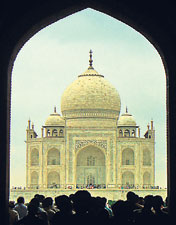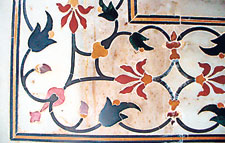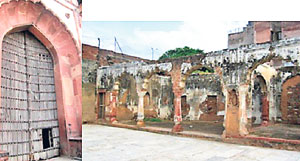“Why not visit the Taj Mahal?” suggested my Indian friend Kethan mentioning the world famous monument that is just a three to four hour drive from New Delhi. Kethan dialled the Delhi Tourism office to get me a seat on the next day’s round trip. It was over-booked but the officer finally agreed. I had to be there at the Delhi Tourism entrance sharp at 6, the next morning.
I reached Delhi Tourism well ahead of time the next morning. The area which was deserted the previous night had transformed into Delhi’s flower market. Vividly coloured flower baskets were everywhere. Roses, carnations, and marigolds were sold to buyers loudly bargaining like we do in a fish market.
Inhaling the fragrance of the fresh flowers, I boarded the vehicle arranged for the tour. It was a multi-cultural crowd- two Irish girls, a Chinese, a Japanese and a tourist from Britain. A Canadian girl had just phoned the driver saying she was lost in the town. She arrived 45 minutes late and the driver took off at an accelerated speed to make up for the lost time.
 |
| Taj Mahal - Through an arch |
It was about a 200 kilometre journey from New Delhi to Agra and we had to cross the border of Uttar Pradesh state. Vehicles have to get clearance when crossing the borders of Indian states so there was a queue. There were gypsies with monkeys who flocked around the waiting vehicles like vultures begging for money. Our driver warned us to keep the shutters closed.
Getting breakfast on the way, we reached Agra around 11 a.m. To avoid damage to the white marble of the Taj Mahal through air pollution, fuel-driven vehicles are not allowed close by. We got down and boarded a battery-driven mini bus to reach the southern gates of the Taj Mahal. There are also camel carts available for the tourist who wants a different experience.
The entrance ticket which is only Rs.20 for an Indian is Rs.750 for a foreign tourist. Visitors from the SAARC region however get the tickets for a concessionary rate, so check the prices at the counter before you buy them and present your passport.
After the security checks, we were allowed to go through the Taj Mahal’s Southern Gate. A special pair of disposable socks was also given to cover our shoes to avoid harmful dust on the World Heritage monument.
Through a few more passages and arches, we proceeded amidst a slight drizzle, carried along with the crowd. The Taj Mahal first appeared before us through the end of these passages and it was really fascinating to be in front of one of the most beautiful buildings of the world. But the real beauty and wonder of the Taj Mahal could only be seen at close proximity. Built of white marbles, the artwork is all done using stone. At a distance the differently coloured designs on the arches seem painted, but they are in fact made by embedding coloured small pieces of stone into the structure. No wonder it had taken 22 years to build. For me the real wonder of Taj Mahal lies in this artwork which showcases the patience and craftsmanship of the Mughals.
 |
| Intricate work on tiles at the Taj Mahal |
The Taj Mahal was constructed using materials from all over India and Asia and the labour of over 1,000 elephants as per ancient records. In all, 28 types of precious and semi-precious stones were inlaid into the white marble. The translucent white marble was brought from Makrana, Rajasthan, the jasper from Punjab, jade and crystal from China, turquoise was from Tibet and the lapis lazuli from Afghanistan, carnelian from Arabia while the sapphires were got down from Sri Lanka. I felt proud that our precious stones too become part of this masterpiece.
The seventh wonder of the world, Taj Mahal is also stands as a symbol of love. The story is famous- how the fifth Mughal emperor Shah Jahan built this monument in memory of his beautiful wife Mumtaz Mahal who died at the birth of their 14th child. The grief-stricken emperor ordered the construction of the Taj Mahal in 1632, one year after her death. Mumtaz’s body was buried in the centre of the building and later emperor Shah Jahan in the next building.
Tourists are allowed to visit the inner chambers of this tomb where the lovers rest today. Our tour guide explained a tradition that wishes made in front of these tombs of the Taj Mahal lovers come true. If you visit the Taj Mahal, be mindful of the ‘No photographs” signs to avoid arguments with security guards.
The hidden crumbling monuments of Delhi
By Radhika Rao
Returning from New York to New Delhi this summer, I was excited, about seeing the magnificent monuments that I had read about. But I was to be disappointed not by the lack of beauty but by the lack of maintenance and the lack of care displayed towards the country’s history and culture.
Through my journey exploring the hidden monuments of Delhi, I found many dilapidated monuments, among them three that caught my eye. These were Khirki Masjid, Bahadur Shah Zafar Mahal, and the monuments inside the Meharauli Archaeological Park. Most Indians, even those living in Delhi, perhaps do not know that these places exist.
Khirki Masjid built during the Tughlaq period (1320-1413 AD) is a fine example of Islamic architecture. It is one of the only mosques to have a roof and has beautifully carved windows with intricate lattice work. But regretfully the maintenance was appalling.
To get to Khirki Masjid, we had to go through a small village, with dusty, bad roads making it almost impossible for cars to pass through. I was surprised to find that the Hindu-Muslim divide still prevailed in Delhi. Trying to find the mosque, I asked several people, most of whom were probably Hindus, and they appeared to feign ignorance about the fact that there was a mosque situated in their village. It wasn’t until we met a Muslim vegetable seller that we were able to locate the mosque.
 |
| Crumbling arches: Hathi Gate |
The facade of the mosque was crumbling; the roof was breaking down. Surrounding it was an unkept garden, badly in need of grass. The sound of stray dogs barking echoed inside the mosque and the stench of the bats was the first odour that greeted us. The inside of the mosque, however, wasn’t disappointing as the beauty of the latticed windows were a true eye opener.
Zafar Mahal, is considered to be the last monumental structure built by the Mughals. It was the summer palace of the last Mughal ruler of India, Bahadur Shah Zafar II. Built in 1842 by Akbar Shah II, the entrance to the palace or mahal has an imposing gate, built as a three-storied structure in red sandstone embellished with marble. It is about 50 feet (15 metres) wide, and is called the Hathi gate - built to allow fully caparisoned elephants to pass through. The gate is the only part of the mahal which is still in reasonable condition. As soon as you enter the mahal, you see that the arches are crumbling. The intricate carvings could barely be seen due to the immense amount of dust that had collected on them over the years.
There are several monuments inside the Mehrauli Archaeological Park, but the one that needs the most attention is Rajaon Ki Baoli. It is a four-tier step-well built in the 16th century. It is part of the fort (Lalkot) in the Qutub Minar complex and is described by Marie-Luise Gothein, in her book on Indian Gardens. However, little remains of the garden, now overgrown with shrubs. On the walls, dust and graffiti hide most of the beautiful and intricate carvings. Once supposed to be a striking lilac pink, it has now become dirty white. However, the monument is not totally dilapidated. With a little care and interest, it can be returned to its previous state.
Khirki Masjid was one of the 43 monuments identified by the Archaelogical Survey of India for restoration before the 2010 Commonwealth Games. Some conservation work has started inside the mosque but a lot more needs to be done.
As for the Meharauli Archaeological Park, the Delhi State Department of Archaeology issued a preliminary notification to restore more than a dozen monuments in the Park.
The Zafar Mahal is also listed as a monument for conservation. ASI has proposed to set up a Mughal Museum in this palace.
One hopes that as people become more aware about these forgotten monuments there will be pressure on the government to preserve and restore them. |




